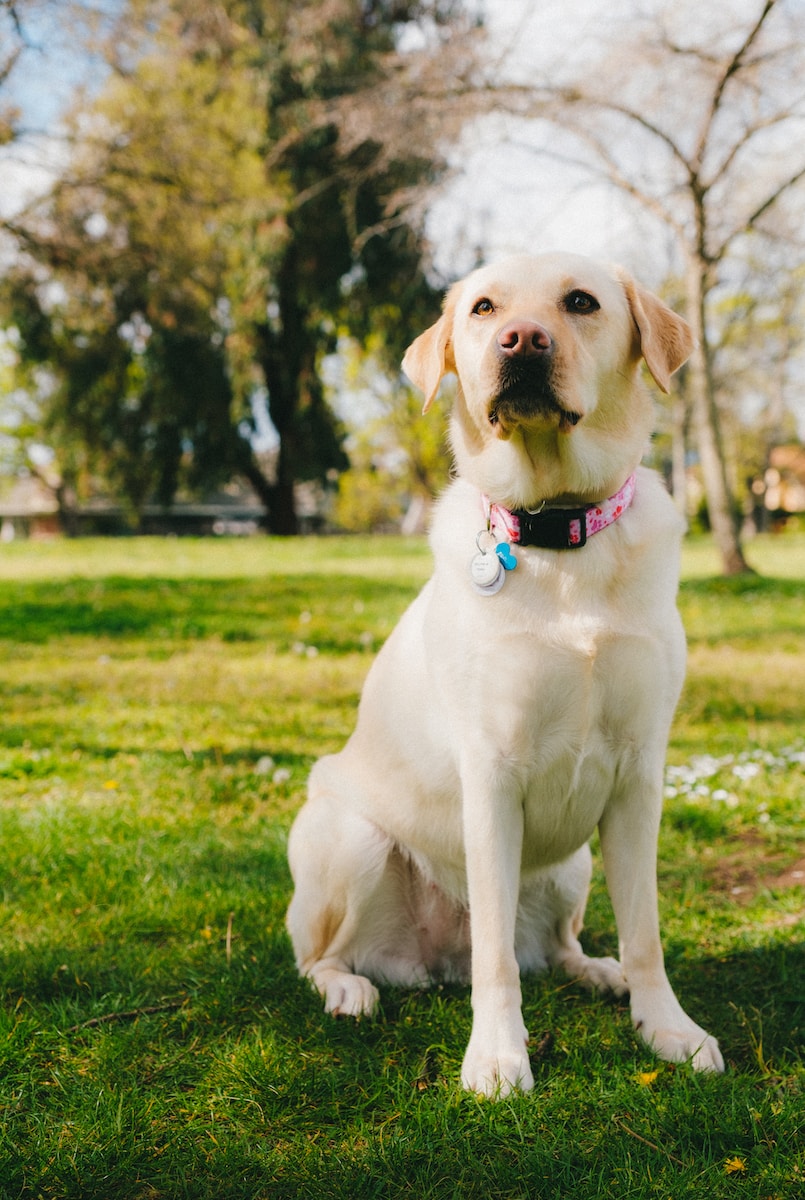No introduction is necessary for the breed of Labrador Retriever. This adaptable sporting dog has won the hearts of dog lovers worldwide and has been the most popular breed in the United States for 30 years. Labradors are a breed that combines flair and substance. They are renowned for their amiable demeanor, loyalty, and intellect. They are the ideal combination of elegance and practicality, making them an excellent choice for families and hunters.
The Labrador Retriever’s physical characteristics testify to its versatility as a sporting breed. Their short, dense coat is weatherproof and protects from harsh elements, making them an ideal dog for hunting in icy waters. Their broad head and heavy body give them the strength to retrieve the game without sacrificing agility and speed.
Working dogs have an innate desire to please their owners, making them highly trainable and reliable. Whether romping around with children in the backyard or retrieving ducks in the field, Labradors are a breed that excels in adapting to their environment while maintaining their natural grace and charm.

Key Takeaways
- Labrador Retrievers are the most popular breed in the US and are versatile sporting dogs.
- They are friendly, loyal, and intelligent, making them excellent companions for families and hunters.
- Their physical characteristics, such as their short, dense, weatherproof coat and broad head, demonstrate their strength and agility.
- While generally healthy, Labrador Retrievers require regular vet check-ups, a healthy diet/exercise routine, and proper coat care and grooming to maintain their health and shine.
Physical Appearance and Temperament
Physical Appearance:
Labrador Retrievers are medium to large-sized dogs with a well-balanced and muscular build. They have a broad heads, kind eyes, and a friendly expression. Their ears hang down close to their head and are set slightly back. Labradors have a thick, dense coat that is waterproof and comes in three primary colors: black, yellow, and chocolate. The breed’s tail is thick at the base and gradually tapers toward the tip.
Temperament:
Labradors are renowned for their friendly, outgoing, and gentle nature. They are excellent family pets and get along well with children, other dogs, and even strangers. Their friendly disposition often disqualifies them from being effective guard dogs, as they are more likely to greet a burglar with wagging tails than with aggression.
Training and Socialization
Training and socialization are crucial aspects of raising a well-behaved Labrador Retriever. These intelligent and eager-to-please dogs respond well to positive reinforcement methods. Early training should focus on basic commands such as sit, stay, come, and heel. Consistency, patience, and rewards-based training methods are key to successfully training a Labrador.
Socialization is equally important to ensure your Labrador grows into a well-rounded and confident dog. Exposing them to various environments, people, and other animals from an early age helps prevent behavioral issues and promotes their adaptability.
Health and Care
Caring for a Labrador Retriever involves meeting their basic needs, ensuring their health and well-being, and providing them with plenty of love and attention. Here are some essential aspects of Labrador care:
1. Feeding and Nutrition: A balanced diet is essential for keeping your Labrador healthy and active. High-quality commercial dog food that meets their nutritional requirements is readily available. It is important to monitor their food intake and avoid overfeeding, as Labradors have a tendency to gain weight.
2. Exercise Requirements: Labradors are energetic dogs requiring regular exercise to stimulate them physically and mentally. Daily walks, playtime, and interactive activities such as retrieving games are ideal for meeting their exercise needs. A tired Labrador is a happy and well-behaved Labrador.
3. Regular Veterinary Care: Regular check-ups with a veterinarian are crucial to ensure the overall health and well-being of your Labrador Retriever. Routine vaccinations, parasite prevention, dental care, and annual physical examinations are important aspects of preventive healthcare. Regular vet visits also allow for early detection and treatment of any potential health issues.
4. Mental Stimulation: Labradors are intelligent dogs that thrive on mental stimulation. Engage their minds with puzzle toys, obedience training, and interactive games. Mental stimulation helps prevent boredom and destructive behaviors.
5. Love and Attention: Labradors are social animals that crave human companionship. They thrive in a loving and nurturing environment, so be sure to give them plenty of affection, attention, and positive reinforcement. Regular bonding activities such as cuddling, grooming, and training sessions strengthen the bond between you and your Labrador.
Common Health Issues
Like all dog breeds, Labrador Retrievers are prone to certain health issues. Being aware of these conditions can help you take proactive measures to ensure your dog’s well-being. Some common health issues seen in Labradors include:
Hip and Elbow Dysplasia:
Labradors are susceptible to hip and elbow dysplasia, which is the abnormal development of these joints. This can lead to discomfort, lameness, and arthritis.
Obesity:
Labradors have a tendency to overeat and gain weight. Obesity can lead to various health problems, including joint issues, diabetes, and heart disease. It is essential to monitor their diet and provide regular exercise to prevent obesity.
Progressive Retinal Atrophy (PRA):
PRA is a genetic eye disorder that can cause progressive vision loss and eventually blindness in Labradors. Regular eye examinations by a veterinarian can help detect and manage this condition.
Exercise-Induced Collapse (EIC):
EIC is a condition that affects Labradors during intense exercise or excitement. It leads to weakness, loss of coordination, and sometimes collapse. Care should be taken to avoid triggering episodes of EIC through controlled exercise and avoiding stressful situations.
Ear Infections:
Labradors have floppy ears, which can trap moisture and debris, making them prone to ear infections. Regular ear cleaning and inspection can help prevent infections.
It is important to note that not all Labradors will experience these health issues, and responsible breeding practices can help reduce the risk of inherited conditions. Regular veterinary check-ups, a balanced diet, exercise, and preventive care go a long way in maintaining the health of your Labrador Retriever.
Nutrition and Exercise
Nutrition:
Proper nutrition is crucial for the overall health and well-being of Labrador Retrievers. A balanced diet that meets their nutritional requirements is essential. Here are some key points to consider when it comes to feeding your Labrador:
- Quality Dog Food: Choose a high-quality commercial dog food that is specifically formulated for Labrador Retrievers or large breed dogs. Look for a product that lists a quality protein source (such as chicken or lamb) as the first ingredient and avoids excessive fillers and artificial additives.
- Feeding Schedule: Divide your Labrador’s daily food allowance into two or three meals to maintain a consistent feeding schedule. This can help prevent bloating and aid in digestion.
- Portion Control: Labradors have a tendency to overeat, so it is important to monitor their food intake and avoid overfeeding. Follow the recommended portion sizes provided by the dog food manufacturer and adjust as needed based on your dog’s age, activity level, and overall body condition.
- Treats in Moderation: Treats can be used as rewards during training or as occasional indulgences. However, be mindful of the calorie content and choose healthy, low-calorie treats to avoid excessive weight gain.
Exercise:
Labradors are an active breed that requires regular exercise to stay healthy and happy. Here are some guidelines for exercising your Labrador Retriever:
- Daily Physical Activity: Aim for at least 30 to 60 minutes of exercise every day. This can include walks, jogging, swimming, playing fetch, or participating in canine sports such as agility or obedience training.
- Mental Stimulation: Labradors also need mental stimulation in addition to physical exercise. Engage them in puzzle toys, obedience training sessions, and interactive play to keep their minds sharp and prevent boredom.
- Be Mindful of Your Labrador’s Limitations: Labradors are energetic but can also be prone to conditions like hip dysplasia. Avoid activities that strain their joints excessively, especially during their growth phase. Consult your veterinarian about appropriate exercise levels for your Labrador based on age, health, and individual needs.
Regular exercise keeps your Labrador physically fit and helps channel its energy, prevents behavioral issues, and promotes a strong bond between you and your furry friend.
Grooming Tips
Labrador Retrievers have a short, dense, and water-resistant double coat that requires regular grooming to keep them looking their best. Here are some grooming tips for your Labrador:
- Brushing: Labradors shed moderately throughout the year and experience heavier shedding during seasonal changes. Regular brushing with a slicker brush or a grooming mitt helps remove loose hair and minimizes shedding. It also helps distribute the natural oils in their coat, keeping them healthy and shiny.
- Bathing: Labradors are generally clean dogs and do not require frequent baths. Aim for bathing them every two to three months or as needed. Use a dog-specific shampoo that is gentle on their skin and coat. Avoid over-bathing, as it can strip the natural oils from their skin, leading to dryness and irritation.
- Nail Trimming: Regular nail trims are essential to prevent overgrowth, discomfort, and potential injuries. Trim your Labrador’s nails every four to six weeks or as needed. Be cautious not to cut too close to the quick, which is the sensitive part inside the nail.
- Ear Cleaning: Labrador Retrievers are prone to ear infections due to their floppy ears. Clean their ears regularly with a veterinarian-approved ear cleaner to remove dirt, wax, and moisture. Avoid inserting anything deep into the ear canal, and seek professional guidance if you notice signs of infection or discomfort.
- Dental Care: Good oral hygiene is important for your Labrador’s overall health. Regularly brush their teeth with a dog-specific toothbrush and toothpaste to prevent tartar buildup, gum disease, and bad breath. Dental chews or toys designed to promote dental health can also be beneficial.
- Professional Grooming: While Labradors do not require professional grooming like long-haired breeds, you may opt for professional grooming services for specific needs such as nail trimming, ear cleaning, or a thorough coat cleaning and inspection.
Maintaining a regular grooming routine can help keep your Labrador Retriever’s coat healthy, minimize shedding, and ensure their overall cleanliness and comfort.
Labrador Retriever Colors

Labrador Retrievers come in three primary colors recognized by breed standards: black, yellow, and chocolate. The coat color is determined by genetics, and each color has its own unique charm.
- Black Labradors: Black is the most common coat color for Labradors. Their sleek black coat gives them a classic and elegant appearance. Despite the color, black Labradors have the same friendly temperament and loving nature as their yellow and chocolate counterparts.
- Yellow Labradors: Yellow Labradors range in the shade from a light cream to a rich fox red. They have a warm and sunny disposition that matches their coat color. Yellow Labradors often have beautiful, expressive eyes that add to their charm.
- Chocolate Labradors: Chocolate Labradors have a rich, brown coat that can vary in shade from light to dark chocolate. Their coat color often comes with a velvety texture that is irresistible to touch. Chocolate Labradors have a reputation for being loyal and affectionate companions.
It’s important to note that coat color does not affect a Labrador’s temperament or abilities. Regardless of the color, Labradors are known for their friendly, playful, and loving nature.
Working and Sporting Abilities
The Labrador Retriever is equipped for various working and sporting activities with its robust build and weatherproof coat. This breed is renowned for its ability to retrieve game in icy waters, making it a popular choice for hunters and fishermen.
The Labrador Retriever’s excellent sense of smell, strength, and endurance make it an ideal hunting companion. In addition to hunting, this versatile breed is well-suited for participating in agility trials, showcasing its athleticism and intelligence.
To excel in these various activities, proper training techniques are imperative. Labrador Retrievers are highly trainable and respond well to positive reinforcement methods. Consistency and patience are key when training this breed, as their surroundings can easily distract them.
Hunting and retrieving competitions require specialized training, including obedience, tracking, and retrieving drills. With the proper training and guidance, Labrador Retrievers can excel in these activities and make excellent companions for those who enjoy outdoor sports.

Related Breeds
In addition to the Labrador Retriever, several other breeds possess similar traits and characteristics. One of these breeds is the Golden Retriever, a popular breed among families due to its friendly and loyal nature. Like the Labrador, Golden Retrievers are also sporting dogs and excel in activities such as hunting, agility, and obedience competitions. They also have a similar physical appearance: a broad head, strong jaws, and a dense, weatherproof coat.
The Chesapeake Bay Retriever is another breed similar to the Labrador Retriever. This breed is known for its strong swimming and retrieving skills, making them ideal for hunting in rough waters. Like the Labrador, the Chesapeake Bay Retriever also has a dense, waterproof coat that protects them from cold temperatures.
Adoption options are available for all of these breeds, and potential owners should research each breed’s temperament and need before deciding.
Famous Labrador Retrievers
Labrador Retrievers have left their pawprints in popular culture and history. One of the most famous Labradors is “Marley” from the best-selling book and movie “Marley & Me,” written by John Grogan. Marley’s mischievous antics and unwavering loyalty won the hearts of millions worldwide. Another notable Labrador is “Endal,” an assistance dog who gained international recognition for his remarkable skills and dedication to his owner, Allen Parton.
Choosing a Labrador Retriever
When considering adding a Labrador Retriever to your family, it’s essential to find a reputable breeder or consider adoption from a rescue organization. A responsible breeder will prioritize the health and temperament of their dogs, ensuring they come from good genetic lines. Adoption provides an opportunity to give a loving home to a Labrador in need.
Labrador Retrievers require an active and loving family environment to thrive. Before committing, their exercise needs, socialization, and mental stimulation should be considered. With the proper care and attention, a Labrador Retriever can bring your life years of joy and companionship.
Frequently Asked Questions
Are Labrador Retrievers good with children?
Yes, Labrador Retrievers are known for being excellent family dogs and are generally good with children. They are patient and gentle, making them great companions and playmates for kids. However, supervision and teaching children how to interact with dogs appropriately are important as with any dog.
How much exercise do Labrador Retrievers need?
Labradors are an active breed and require significant exercise to stay healthy and happy. Aim for at least 30 to 60 minutes of exercise daily, including walks, playtime, and interactive games. Regular exercise helps prevent behavioral issues and promotes their overall well-being.
Do Labradors shed a lot?
Labradors have a short, dense, and water-resistant double coat that sheds moderately throughout the year. They experience heavier shedding during seasonal changes. Regular brushing helps remove loose hair and minimizes shedding. While they do shed, Labradors are generally considered to be moderate shedders compared to some other breeds.
Are Labradors easy to train?
Labrador Retrievers are intelligent and eager to please, which makes them relatively easy to train. They respond well to positive reinforcement methods and thrive in training environments that include rewards, consistency, and patience. Early socialization and training are important to ensure they grow up to be well-behaved and obedient dogs.
Are Labradors good for first-time dog owners?
Labradors can be a good choice for first-time dog owners due to their friendly and trainable nature. However, they require commitment, time, and effort in exercise, grooming, and training. First-time owners need to research and understand the breed’s needs and be prepared to provide proper care and training.
How long do Labradors usually live?
Labrador Retrievers have an average lifespan of 10 to 12 years. However, with proper care, a healthy diet, regular exercise, and regular veterinary check-ups, some Labradors can live well into their teens.
Conclusion
Finally, bringing a Labrador Retriever into your household can bring great happiness and companionship. These dogs are great friends for individuals and families because of their amiable demeanor, intelligence, and loyalty.
Bone Voyage Dog Rescue is an organization devoted to ensuring that stray and unwanted dogs in Mexico can find their permanent homes in Canada and the US. If you’re passionate about seeing this happen. They offer these dogs a safe sanctuary and put forth great effort to place them with devoted families who will appreciate them.
Participating with Bone Voyage Dog Rescue will help the world. Your support can help these worthy pets live better by contributing your time, providing foster care, or contributing.
